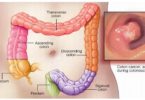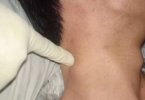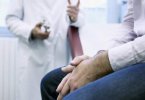Testicular cancer occurs in one or both of the testicles (testes), the testicles are 2 egg-shaped glands located inside the scrotum (a sac of loose skin that lies directly below the penis). The testicles are held within the scrotum by the spermatic cord, which also contains the vas deferens and vessels and nerves of the testicles. The testicles are the male sex glands and produce testosterone and sperm. Germ cells within the testicles produce immature sperm that travel through a network of tubules (tiny tubes) and larger tubes into the epididymis (a long coiled tube next to the testicles) where the sperm mature and are stored. Testicular cancer mainly affects young men between the ages of 20 and 39. Testicular cancer is highly treatable, even when cancer has spread beyond the testicle. Depending on the type and stage of testicular cancer, you may receive one of several treatments, or a combination. Regular testicular self-examinations can help identify growths early, when the chance for successful treatment of testicular cancer is highest.
Causes
The exact causes of testicular cancer are not known. However, studies have shown that several factors increase a man’s chance of developing this disease.
- Undescended testicle (cryptorchidism): Normally, the testicles descend from inside the abdomen into the scrotum before birth. The risk of testicular cancer is increased in males with a testicle that does not move down into the scrotum. This risk does not change even after surgery to move the testicle into the scrotum. The increased risk applies to both testicles.
- Congenital abnormalities: Men born with abnormalities of the testicles, penis, or kidneys, as well as those with inguinal hernia (hernia in the groin area, where the thigh meets the abdomen), may be at increased risk.
- History of testicular cancer: Men who have had testicular cancer are at increased risk of developing cancer in the other testicle.
- Family history of testicular cancer: The risk for testicular cancer is greater in men whose brother or father has had the disease.
Symptoms
Signs and symptoms of testicular cancer include:
- A lump or enlargement in either testicle
- A feeling of heaviness in the scrotum
- A dull ache in the abdomen or groin
- A sudden collection of fluid in the scrotum
- Pain or discomfort in a testicle or the scrotum
- Enlargement or tenderness of the breasts
- Back pain
- Cancer usually affects only one testicle.
See your doctor if you detect any pain, swelling or lumps in your testicles or groin area, especially if these signs and symptoms last longer than two weeks.
Tests and Diagnosis
Tests that examine the testicles and blood are used to detect (find) and diagnose testicular cancer.
The following tests and procedures may be used:
- Physical exam and history : An exam of the body to check general signs of health, including checking for signs of disease, such as lumps or anything else that seems unusual. The testicles will be examined to check for lumps, swelling, or pain. A history of the patient’s health habits and past illnesses and treatments will also be taken.
- Ultrasound exam: A procedure in which high-energy sound waves (ultrasound) are bounced off internal tissues or organs and make echoes. The echoes form a picture of body tissues called a sonogram.
- Serum tumor marker test : A procedure in which a sample of blood is examined to measure the amounts of certain substances released into the blood by organs, tissues, or tumor cells in the body. Certain substances are linked to specific types of cancer when found in increased levels in the blood. These are called tumor markers. The following tumor markers are used to detect testicular cancer:
- Alpha-fetoprotein (AFP).
- Beta-human chorionic gonadotropin (β-hCG).
- Tumor marker levels are measured before inguinal orchiectomy and biopsy, to help diagnose testicular cancer.
- Inguinal orchiectomy: A procedure to remove the entire testicle through an incision in the groin. A tissue sample from the testicle is then viewed under a microscope to check for cancer cells. (The surgeon does not cut through the scrotum into the testicle to remove a sample of tissue for biopsy, because if cancer is present, this procedure could cause it to spread into the scrotum and lymph nodes. It’s important to choose a surgeon who has experience with this kind of surgery.) If cancer is found, the cell type (seminoma or nonseminoma) is determined in order to help plan treatment.
Treatment
The options for treating your testicular cancer depend on several factors, including the type and stage of cancer, your overall health, and your own preferences. Seminomas and nonseminomas grow and spread differently and are treated differently. Nonseminomas tend to grow and spread more quickly; seminomas are more sensitive to radiation. If the tumor contains both seminoma and nonseminoma cells, it is treated as a nonseminoma. Treatment also depends on the stage of the cancer, the patient’s age and general health, and other factors. Treatment is often provided by a team of specialists, which may include a urologist (a surgeon who specializes in diseases of the genital and urinary systems), a medical oncologist, and a radiation oncologist.
Surgery
Operations used to treat testicular cancer include:
- Surgery to remove your testicle (radical inguinal orchiectomy) is the primary treatment for nearly all stages and types of testicular cancer. To remove your testicle, your surgeon makes an incision in your groin and extracts the entire testicle through the opening. A prosthetic, saline-filled testicle can be inserted if you choose.
- Surgery to remove nearby lymph nodes (retroperitoneal lymph node dissection) is performed through an incision in your abdomen. Your surgeon takes care to avoid damaging nerves surrounding the lymph nodes, but in some cases harm to the nerves may be unavoidable. Damaged nerves can cause difficulty with ejaculation, but won’t prevent you from having an erection.
In cases of early-stage testicular cancer, surgery may be the only treatment needed.
If surgery is your only treatment for testicular cancer, your doctor will recommend a schedule of follow-up appointments. At these appointments typically every few months for the first few years and then less frequently after that you’ll undergo blood tests, CT scans and other procedures to check for signs that your cancer has returned.
Radiation Therapy
Radiation therapy (also called radiotherapy) uses high-energy rays to kill cancer cells and shrink tumors. It is a local therapy, meaning that it affects cancer cells only in the treated areas. External radiation (from a machine outside the body), aimed at the lymph nodes in the abdomen, is used to treat seminomas. It is usually given after surgery. Because nonseminomas are less sensitive to radiation, men with this type of cancer usually do not undergo radiation therapy. Radiation therapy affects normal as well as cancerous cells. The side effects of radiation therapy depend mainly on the treatment dose. Common side effects include fatigue, skin changes at the site where the treatment is given, loss of appetite, nausea, and diarrhea. Radiation therapy interferes with sperm production, but many patients regain their fertility over a period of 1 to 2 years.
Chemotherapy
Chemotherapy is the use of anticancer drugs to kill cancer cells. When chemotherapy is given to testicular cancer patients, it is usually given as adjuvant therapy (after surgery) to destroy cancerous cells that may remain in the body. Chemotherapy may also be the initial treatment if the cancer is advanced; that is, if it has spread outside the testicle at the time of the diagnosis. Most anticancer drugs are given by injection into a vein. Chemotherapy is a systemic therapy, meaning drugs travel through the bloodstream and affect normal as well as cancerous cells throughout the body. The side effects depend largely on the specific drugs and the doses.
Common side effects include nausea, hair loss, fatigue, diarrhea, vomiting, fever, chills, coughing/shortness of breath, mouth sores, or skin rash. Other side effects include dizziness, numbness, loss of reflexes, or difficulty hearing. Some anticancer drugs also interfere with sperm production. Although the reduction in sperm count is permanent for some patients, many others recover their fertility. Some men with advanced or recurrent testicular cancer may undergo treatment with very high doses of chemotherapy. These high doses of chemotherapy kill cancer cells, but they also destroy the bone marrow, which makes and stores blood cells. Such treatment can be given only if patients undergo a stem cell or bone marrow transplant. In a transplant, bone marrow stem cells or stem cells collected from the bloodstream are removed from the patient before chemotherapy is administered. These cells are frozen temporarily and then thawed and returned to the patient through a needle (like a blood transfusion) after the high-dose chemotherapy has been administered.
Men with testicular cancer should discuss their concerns about sexual function and fertility with their doctor. It is important to know that men with testicular cancer often have fertility problems even before their cancer is treated. If a man has pre-existing fertility problems, or if he is to have treatment that might lead to infertility, he may want to ask the doctor about sperm banking (freezing sperm before treatment for use in the future). This procedure allows some men to have children even if the treatment causes loss of fertility.
Prevention
There’s no way to prevent testicular cancer.
Some doctors recommend regular testicle self-examinations to identify testicular cancer at its earliest stage. But not all doctors agree. Discuss testicular self-examination with your doctor if you’re unsure about whether it’s right for you.
If you choose to do a testicular self-examination, a good time to examine your testicles is after a warm bath or shower. The heat from the water relaxes your scrotum, making it easier for you to find anything unusual.
To do this examination, follow these steps:
- Stand in front of a mirror. Look for any swelling on the skin of the scrotum.
- Examine each testicle with both hands. Place the index and middle fingers under the testicle while placing your thumbs on the top.
- Gently roll the testicle between the thumbs and the fingers. Remember that the testicles are usually smooth, oval shaped and somewhat firm. It’s normal for one testicle to be slightly larger than the other. Also, the cord leading upward from the top of the testicle (epididymis) is a normal part of the scrotum. By regularly performing this exam, you can become more familiar with your testicles and aware of any changes that might be of concern.
- If you find a lump, make an appointment with your doctor.
Prognosis
Treatment of testicular cancer was called one of the success stories of modern medicine, with sustained response to treatment in more than 90% of cases, regardless of stage.





